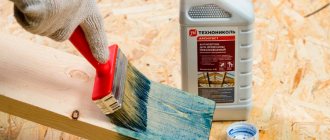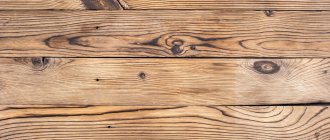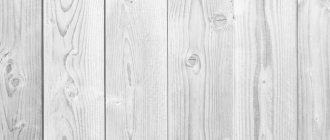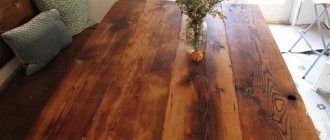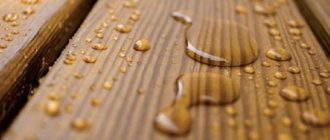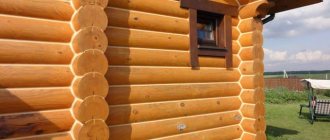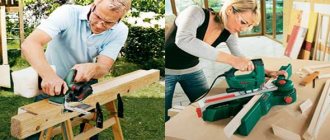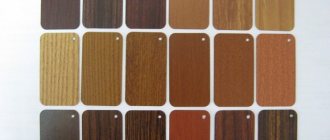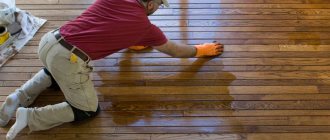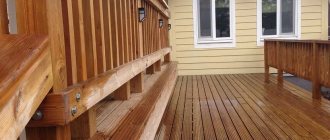Wood impregnations penetrate deeply into the structure of the material, creating a thin film on its surface. At the same time, they do not disrupt natural vapor exchange and do not interfere with the evaporation of moisture. Moreover, the use of impregnations allows you to extend the service life of wooden structures several times.
Impregnations for interior work can protect wood from mold, mildew, increase its fire resistance, etc. The market offers a wide range of impregnations for interior work. Let's understand the advantages and features of each composition.
What types of wood impregnations are there?
Let us note that there are a variety of impregnations for wood, and a variety of substances that are used in one way or another or are theoretically suitable for use can also be classified in this group. Humanity has known wood as a building material since the beginning of time, so a huge amount of experience has been accumulated.
Attention! We do not review all antiseptics and do not pretend to have an exhaustive catalog of them; we review the most relevant drugs available on the market today.
Packing
The products are presented for the convenience of consumers in plastic containers; the packaging includes three volumes. You can buy buckets with a volume of 0.75, 2.5 and 10 liters. Before purchasing, it is recommended to calculate the required amount of solution for the surface to be treated.
Before purchasing, it is recommended to calculate the required amount of solution for the surface to be treated.
Main groups
As was said, there are a lot of impregnations, so we will divide them into groups to make it easier to navigate through all this diversity. As a unifying criterion, we will choose one or another distinctive feature of goods belonging to the same group, be it composition, scope of application, basic properties or something else.
Impregnations for wood:
- decorative, protective and mixed;
- natural, synthetic and mixed;
- moisture-resistant and water-repellent;
- water-based and organic solvent-based;
- oil and wax;
- imparting fire retardant properties;
- antiseptics against rot and mold;
- fire-retardant compounds;
- tinting and colorless;
- for external and internal work;
- salt-based and organic compounds.
If you need to protect a wooden product from moisture, you need to answer a number of questions:
- Where will the product be used, indoors or outdoors?
- How will the part be used, for what purposes?
- Who and what will come into contact with the product, will children or food be included in this list?
- What humidity regime is expected? Will there be direct contact with water?
- What should the part look like in its final form?
After answering these questions, you will have an idea of the requirements that the drug must meet. Next, it remains to choose the right one.
Storage
Storage rules require leaving the impregnation in a dry, cool place in a tightly closed container. If the package has already been opened, the shelf life will be a month; a closed container can be stored for 24 months. The storage location must be protected from frost.
Storage rules require leaving the impregnation in a dry, cool place in a tightly closed container.
Dufa impregnation is a high-quality option for treating the surface of wood from the effects of environmental factors, as well as for creating a waterproof coating. The application process is simple, so you can do it yourself, the main thing is not to skip the stage of preparing the base.
Antiseptic impregnations
Antiseptic impregnations constitute, perhaps, the widest and most popular group of products in this class. This is due to the fact that it is antiseptic treatment that allows you to get rid of the most harmful pests - bacteria and molds, wood-eating insects and other biological agents that cause corrosion of the material.
Experts know that moisture, as such, is not particularly harmful to wood.
The problem is that it creates an environment for the development of various microorganisms, such as mold and bacteria. But they are already beginning to cause serious harm: causing rot, turning them blue or gray, consuming cellulose as food, turning the product into dust. Antiseptics are:
- transport, such as GOODHIM T 151;
- for baths and saunas, for example, GOODHIM S200;
- gels with high penetrating effect GOODHIM 230 IMPREGNANT;
- For interior and exterior use;
- difficult to wash out and unwashable;
- tinting and colorless;
- from insects like GOODHIM 100 “Stopzhuk”;
- for end protection like GOODHIM TOR GBS.
The effect of antiseptic impregnations is based on the content of biocidal and fungicidal components in the composition. Transport or temporary antiseptics are designed to protect lumber during storage, delivery and construction. They are inexpensive and are quickly washed away by rain, so they serve only as a temporary measure.
Solutions may contain color pigments that will help paint the product in the desired color and highlight its natural pattern. For light tinting, GOODHIM N300 is good. If this is not necessary, you can choose a composition without color pigments. A prominent representative of such a product is GOODHIM N 320, a colorless, hard-to-wash antiseptic.
Preparations for internal work must meet a lot of safety requirements, especially when in contact with skin or used in children's rooms. Usually they try to use natural ingredients or their analogues.
Important! The main task of the worker is to ensure the necessary consumption of the product during application in order to achieve a certain concentration and penetration to the required depth.
New products from the best manufacturers with water-repellent properties
Aquatex Scandi
An antiseptic model with active decorative functions that has already gained popularity. The main quality of the impregnation was its universal coverage against fungus and moisture. The formula helps renew already used alkyd or acrylic surfaces, even dark shades.
wood protection Aquatex Scandi
Advantages:
- There is an SPF filter;
- Suitable for indoor and outdoor use;
- performed well when interacting with OSB, fiberboard, chipboard plywood, etc.;
- withstands climate changes from -50 to +50;
- contains natural wax;
- the presence of active antiseptic components of a new generation;
- not afraid of wet cleaning using detergents;
- does not crack;
- good covering ability;
- maintains the breathable properties of the material;
- environmental friendliness.
Flaws:
- Do not apply to a damp surface;
- Only use a brush with artificial bristles.
| Type of substance | Acrylic |
| Volume | 9 l |
| Maximum flow | 10 ml per sq. m |
| Drying period | 2 hours |
| Absorbency | 4-6 days |
| What is the price | 4380 ₽ |
NEOMID 430 Eco
The active substances of this composition form a strong connection with the wood texture, due to which they do not evaporate over time and do not lose their protective properties for 35 years, even in difficult conditions. The coating can also be widely used for greenhouses; it will reliably protect the structure:
- from mold spores,
- moss,
- various types of vegetation,
- wood-boring beetles.
wood protection NEOMID 430 Eco
Advantages:
- Average price;
- good operating guarantees;
- long service life
- environmental friendliness;
- does not wash out over time.
Flaws:
- When used, it gives the wood a greenish tint;
- Strong smell.
| Type of substance | Water soluble |
| Volume | 5 kg |
| Maximum flow | 400 grams per sq. m |
| Drying period | 48 hours |
| Absorbency | Deep |
| What is the price | From 996 ₽ |
Tikkurila Supi Arctic
The components of this antiseptic create a special protective coating on the wood, which can then be tinted. This feature allows the composition to be used in any room, regardless of the degree of humidity in the room. It is also suitable for a bath or mini-sauna, as it is impervious to moisture or dirt. The base perfectly preserves the natural wood shade and maintains the integrity of the material.
wood protection Tikkurila Supi Arctic
Advantages:
- High degree of protection;
- good resistance to external factors;
- moisture resistance;
- efficiency;
- no smell;
- ease of application;
- beautiful pearlescent shade;
- There is a possibility for tinting (giving a different color).
Flaws:
- High price.
| Type of substance | Biocidal, water-repellent |
| Volume | 2.7 l |
| Maximum flow | ml per 12 sq. m |
| Drying period | 48 h |
| Absorbency | High |
| What is the price | 3113 ₽ |
Fire protection
This group of impregnations appeared not as long ago as many others. Here, as the name suggests, two types of wood protection are combined - from fire and from biological corrosion. In other words, this product is an antiseptic with the addition of substances that prevent combustion.
To better understand the features of such products, consider the preparations GOODHIM PROF 1-G and GOODHIM PROF 1-G RED. Both products are a mixture of biocides and fire retardants; these are professional preparations that provide the highest fire safety group and high-intensity antiseptic protection. Suitable for use indoors and outdoors in areas of increased fire danger.
Attention! As a rule, the solution slightly tints the wood into a yellowish or reddish tint, but this is not an impregnation paint; this is necessary to control the quality of the processing. During further finishing, this tint can be easily painted over.
Fire-retardant treatment is the key to your safety. This applies to owners of log houses, wooden houses made of laminated or regular timber, owners on whose property there are barns, chicken coops and pigsties made of wood. This treatment is no less important for the boards of roofing rafter systems. View products from the fire and bioprotection group.
How to prepare the surface for processing?
Before antiseptic treatment, it is necessary to prepare the wood for application of the composition. This is done in several stages:
- Surface cleaning. First you need to remove all dirt or formations that have appeared during operation.
- Grinding. All roughness and surface irregularities are removed by grinding. This way the solution will better penetrate the wood texture.
- Degreasing. Helps completely remove grease and dirt accumulated on the surface. The surface is wiped with white spirit applied to a lint-free cloth.
This method of preliminary preparation is suitable both for processing with ready-made solutions and for those prepared independently. After this, you can begin applying the antiseptic.
Decorative and decorative-protective
This group includes various stains, impregnating paints, impregnating varnishes, oil-waxes, drying oils, etc. For example, linen impregnation with the addition of wax, driers and natural resins is at the same time a moisture-proof, decorative and glaze treatment that gives antiparasitic and decorative effects.
Most stains are alcohol-based and organic solvent-based. Such preparations penetrate well into the structure of the material, but increase its flammability and combustibility. At the same time, there is a tinting, hard-to-wash antiseptic GOODHIM N 350, which is water-based and therefore odorless, which is characteristic of any alkyd impregnation. Impregnants are used for deep impregnation of parts that will be exposed to operation in damp rooms, as well as in the open air. They can be used to treat furniture.
Minimum or maximum impregnation?
Different woods require different impregnation treatments. It all depends on the type of wood and how much time has passed since it was processed. There are many exotic tree species with very dense wood that naturally contains tannins and antiseptic substances that protect them from infection by mold and microbes. Neither microorganisms nor insects like freshly cut wood from sequoia, Brazilian cherry, Brazilian teak - cumaru and some other exotic trees. Natural protection remains reliable for 10-12 years. During this time, treatment with impregnations is required either minimally or not at all. In Russia, such species as cedar, oak, larch, yew, and acacia have similar properties.
However, dense wood, protected from harmful biological factors, has a significant drawback - it is too expensive. Therefore, most houses, furniture and other wooden products are made from pine, spruce and other fairly loose species. And here you need to figure out how reliable and durable the protection of the product should be. Depending on the density of the wood, as well as on the climatic conditions in which it will serve, and what kind of finishing coating is expected, a reliable antiseptic impregnation is chosen.
The most serious treatment is called impregnation and is carried out in industrial conditions under full immersion, high pressure and other harsh methods of exposure. In private construction, finishing or carpentry work, complete immersion of small parts in household metal containers and heating are used. For large beams, in the absence of special baths, make a ditch of the required size, lay it out with a durable film, pour in an impregnating composition and keep the material there for the prescribed number of hours.
The process of antiseptic and protective treatment is greatly simplified if you use modern innovative impregnating primers with deep penetration biocides. Such, for example, as GOODHIM IMPREGNANT 230. The composition is applied using conventional methods very easily, thanks to the gel consistency, it penetrates deeply, protects reliably and for a long time, does not cloud the beautiful appearance of the wood and, at the same time, is an excellent primer for almost all types of finishing coatings. With its help, you can also restore the surface of a tree; when all the natural protection has expired, it’s time to take care of an expensive wooden structure or product and update its appearance.
The need to protect wooden elements
The importance of processing wooden structures is difficult to overestimate. Unprotected natural material loses its original characteristics when exposed to natural conditions. Untreated wood begins to rot , is attacked by parasitic insects, and loses its original luster.
Treatment with impregnations allows you to minimize one of the main disadvantages of wood - flammability.
The main factors affecting the integrity of wooden structures:
- UV radiation - destroys lignin, which is the reinforcing frame of wood; the outer surface darkens, becomes porous, and absorbs moisture more actively;
- precipitation – swelling of the material , creating optimal conditions for mold outbreaks and fungal proliferation;
- rodents, pests - violate the integrity;
- acid-base solutions - changes in the physical properties, chemical composition of wood, damage to appearance;
- fire - complete destruction in a short time;
- formation of condensation on the internal elements of the frame .
All wooden elements of a frame house are subject to protection at each construction cycle: floor beams, frame support posts, rafters, trim, sheathing parts, external and internal cladding boards.
What colors of wood impregnations are available on the market?
Wood impregnations, as a rule, are used not only for protection. Beautiful noble wood of a certain species can be very expensive, while with the help of impregnation with oak or walnut pigment, nobility and beauty are achieved at much lower costs. Pine, impregnated with a well-chosen product, can imitate rowan or mahogany, it all depends on your desire. Light wood easily becomes dark, and black impregnation gives the products a special charm and charm.
A no less interesting effect will be achieved by white or gray impregnation, husky colors and even green. Diversity makes our life brighter and richer, and the use of impregnations with different pigments will help diversify the too moderate shades of wood from which your house, fence, furniture or floor is made.
Important! Wood impregnation is not paint, and it does not have a bright coloring effect and a huge richness of shades within the tinting tables. Impregnation adds tone, emphasizes fibers and highlights the natural beauty of the material.
Tinting
The transparent color can be tinted in 45 shades from a special catalogue. A specialized tinting machine is used for this purpose. Among the colors on sale are pine, walnut, teak, white, rosewood, aqua and others.
The transparent color can be tinted in 45 shades from a special catalogue.
Top 10 wood impregnations for outdoor use
The most popular area of application for wood impregnations, especially protective impregnations, is external treatment. Most often they are used for processing the facades of wooden buildings, for opening lining or fence boards, processing doors and window frames, decking boards and garden furniture. To answer the question of which one is better and which one is worse suited to your requirements, you should consider the main positions presented on the Russian market. We have compiled our rating of impregnations, which will help you choose a worthy product.
Table. Impregnations for outdoor use
After impregnation treatment, silicone paint or glaze may be required for additional weather protection. If we continue our TOP 10, we should mention the following manufacturers:
- Biotex;
- Veres;
- Neomid;
- Wood Protect;
- Lapis lazuli;
- Tex.
The assortment usually includes both colorless compositions and products with a variety of shades, for example, mahogany or rosewood. If you need fireproof impregnation, you can buy that too, only the price will be slightly higher.
Drying time
The drying process is influenced by several factors: temperature during operation, room humidity. To understand when you can start using the item fully, you need to study this moment.
Dufa impregnation must be applied in at least two layers, then it will be possible to obtain the required highly effective protective properties for a wooden base. Each layer must dry thoroughly before applying the next; the process usually takes one hour.
Ideal operating conditions: temperature from +20 to +22 degrees, ambient humidity should be approximately 65%.
The complete drying process takes 12 hours. The stage ends 28 days after surface treatment, then full loads can be applied to the treated wood.
The complete drying process takes 12 hours.
Top 10 wood impregnations for interior work
Impregnations for interior work are characterized by increased requirements for safety, composition and odor; on the other hand, indoor wood is subject to much less stress from the environment. There is no direct sunlight, rain, frost and pathogenic microflora with insects. If you need decorative or decorative-protective impregnation for your home, we have compiled a rating especially for you. It will help you understand which impregnation is best suited for your purposes and buy exactly what you need.
Table. Impregnations for interior work
Continuing our TOP 10, I would like to mention the following companies:
- Tikkurila;
- Veres;
- Woodtex;
- Pro-Deco;
- Elkon;
- Elkon-Bio.
If price is an important selection criterion for you, then you better pay attention to the Russian manufacturer. A number of companies offer impregnations that combine decent quality and low cost. An example is the inexpensive but effective products of the Gudhim company.
Important! It is advisable to use only safe antiseptics and impregnations indoors that do not contain compounds that are toxic to humans and animals in dangerous concentrations. A good option would be to treat with impregnant and wood oil.
As in the case of products for outdoor use, preparations for interior use can be presented in the form of colorless impregnations, or they can tint wood in a variety of shades. Proper layer-by-layer application of impregnations with a tinting effect can turn the most ordinary wood into a solid and expensive-looking material.
Technical information
It is recommended to periodically check the product for defects on the surface; it can be done once every 3-4 years. If the indoor surface will be washed frequently during use, then apply the solution in 3 layers. It is also advisable to apply an additional protective varnish for such surfaces.
You should not choose a product for floors and horizontal objects used outdoors. Also, kitchen aprons and shower cabins are not treated with it.
If the indoor surface will be washed frequently during use, then apply the solution in 3 layers.
Frequently asked questions (FAQ)
Where to buy wood impregnation?
You should buy wood impregnations only from official retail outlets that have a trade license and documents for the goods. Buying from hand, through intermediary sites, in spontaneous markets and in other dubious places is fraught with the risk of receiving expired, counterfeit or substandard goods.
A good place to buy would be a large hardware store, a chain hypermarket, or a monobrand showroom-representative office of a company. In addition, it has become a good practice to find out the contacts of official dealers of companies you are interested in in your region using the network, and buy goods from them.
Another channel that has not yet been fully appreciated by Russian buyers is online trading. You can order products directly on the manufacturer’s website; it will not only be cheaper and more reliable, it will protect you from counterfeits, expired goods and other troubles. The manufacturer will be able to easily provide any documents for the product, certificates of quality and compliance with standards.
GOODHIM invites you to visit the updated version of its website, where you can easily understand any issues related to wood impregnations and their purchase.
How to dilute wood impregnation?
If you are faced with the problem of diluting wood impregnation, it is important to know the composition of the product. Further, depending on the result, you can act in different ways. So, if the composition contains water and no organic solvents are indicated, such a preparation can be diluted with water.
You should not assume that water will not ruin the product. Be sure to read the instructions or ask the manufacturer how best to dilute their product, in what proportions this can be done and whether it is worth doing at all. It is often easier to change the product and choose the most suitable one, including consistency.
If you have a concentrate that requires dilution, then carefully read the instructions for use of the product. It will necessarily contain information about the solvent, the ratio of parts when diluting and the procedure for carrying out the procedure. As a rule, drugs are diluted in a ratio of 1:2 – 1:16 depending on the concentration.
Alkyd and other similar impregnations contain an organic solvent. It is advisable to use an identical one for dilution. It happens that the name or formula of a substance is not indicated in the composition, then you can use a universal organic solvent (646, 647, 747, etc.), white spirit or solvent.
Alcohol stains and impregnations should be diluted with alcohol. Both medical and technical ethyl alcohol are suitable.
Important!
Do not use methyl alcohol, it is a dangerous poison, even inhaling its vapors can lead to disastrous consequences.
Remember that by making adjustments to the original composition of the impregnation unnecessarily, you will worsen its properties. As a rule, light dilution of 5 - 10% is allowed in cases where spraying with a spray gun or spray gun is required.
Dilution
If a brush is selected as the processing tool, then there is no need to dilute the solution; you can immediately start using it, only after stirring it first. To use a spray bottle, dilute the product with water; its amount should not exceed 10% of the total volume.
To use a spray bottle, dilute the product with water; its amount should not exceed 10% of the total volume.
